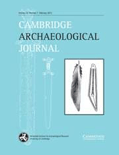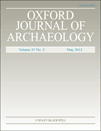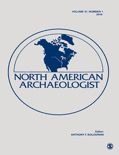
Lithic Technology
Scope & Guideline
Elevating the Discourse in Archaeological Lithics
Introduction
Aims and Scopes
- Lithic Technological Analysis:
The journal emphasizes the detailed analysis of lithic technologies, exploring aspects such as knapping techniques, tool morphology, and manufacturing processes across various prehistoric cultures. - Experimental Archaeology:
A significant portion of the research published involves experimental approaches to understand ancient lithic production, use-wear analysis, and the functional capabilities of stone tools. - Cultural and Temporal Contextualization:
Papers frequently explore the cultural and temporal contexts of lithic technologies, linking archaeological findings with broader anthropological and historical narratives. - Material Science in Lithic Studies:
The journal incorporates studies on the material properties of raw materials used in lithic tool production, including petrology and geochemical analyses, which contribute to understanding sourcing and procurement strategies. - Interdisciplinary Approaches:
Lithic Technology encourages interdisciplinary methodologies, integrating insights from geology, ethnography, and experimental science to provide a holistic understanding of lithic artifacts.
Trending and Emerging
- Integrative Use-Wear Analysis:
There is a growing emphasis on use-wear and residue analysis, with researchers employing advanced methodologies to infer the functional aspects of lithic tools and their roles in prehistoric subsistence strategies. - Technological Efficiency and Resource Management:
Papers are increasingly exploring the efficiency of lithic production strategies and resource management practices, shedding light on the economic behaviors of prehistoric populations. - Interdisciplinary Collaborations:
Emerging studies often incorporate interdisciplinary approaches, combining insights from fields such as material science, digital archaeology, and anthropology to enhance understanding of lithic technologies. - Sustainability and Environmental Impacts:
Recent research has begun to address the sustainability of lithic resource exploitation and the environmental impacts of prehistoric tool-making practices, reflecting broader contemporary concerns. - Cognitive and Social Dimensions of Knapping:
There is an increasing interest in the cognitive and social dimensions of lithic technology, examining how knowledge transmission, skill acquisition, and social practices influenced tool production and usage.
Declining or Waning
- Traditional Typological Studies:
There has been a noticeable decrease in purely typological studies, which categorize tools based on form without integrating functional or contextual analyses. This shift suggests a movement towards more nuanced interpretations that consider the broader implications of tool use. - Descriptive Reports on Isolated Finds:
The publication of studies detailing isolated lithic finds without comprehensive contextualization has diminished, indicating a preference for research that situates artifacts within larger archaeological and cultural frameworks. - Over-reliance on Quantitative Metrics:
While quantitative analyses remain important, there is a declining trend in studies that focus exclusively on metrics without addressing qualitative aspects, such as the socio-cultural implications of lithic technologies.
Similar Journals

Ethnoarchaeology
Empowering Researchers: Your Resource for Groundbreaking EthnoarchaeologyEthnoarchaeology, published by ROUTLEDGE JOURNALS, TAYLOR & FRANCIS LTD, stands at the forefront of interdisciplinary research within the realms of anthropology and archaeology. With an ISSN of 1944-2904 and an E-ISSN of 1944-2890, this journal has demonstrated an impressive impact, categorized in the Q1 quartile for both anthropology and archaeology as of 2023. Acknowledged for its influence, it ranks 72/413 in Archeology (arts and humanities) with an impressive 82nd percentile, making it a vital resource for researchers and practitioners. Over its converged years from 2014 to 2024, the journal aims to bridge theoretical and practical aspects of ethnoarchaeology, fostering a deeper understanding of cultural practices through archaeological perspectives. Its commitment to advancing knowledge in this unique field is of utmost importance for academics, professionals, and students dedicated to exploring the interplay between contemporary societies and historical archaeological practices.

Studijne Zvesti Archeologickeho Ustavu Slovenskej Akademie Vied
Illuminating the archaeological landscape of Slovakia and beyond.Studijne Zvesti Archeologickeho Ustavu Slovenskej Akademie Vied is a leading journal in the field of archaeology, published by the SLOVENSKA AKAD VIED, ARCHEOLOGICKY USTAV, based in Nitra, Slovakia. This esteemed journal, with the ISSN 0560-2793, has established itself as a vital resource for scholars and researchers, reflecting significant academic contributions in both the arts and humanities as well as social sciences. With a 2023 Scopus ranking placing it in the second quartile (Q2) for archaeology, it showcases rigorous research and innovative methodologies, essential for advancing archaeological studies. While it is not an Open Access journal, it continues to offer valuable insights into archaeological findings, theoretical frameworks, and interdisciplinary approaches. The journal serves as a bridge, connecting local Slovak archaeology with international discourse, making it an indispensable tool for students, professionals, and academics striving for a deeper understanding of the archaeological heritage of Slovakia and beyond.

CAMBRIDGE ARCHAEOLOGICAL JOURNAL
Illuminating the Past, Inspiring the FutureThe Cambridge Archaeological Journal, published by Cambridge University Press, is a premier academic journal dedicated to archaeology and cultural studies. With an ISSN of 0959-7743 and an E-ISSN of 1474-0540, it has established itself as a leading platform since its inception in 1991, showcasing groundbreaking research that significantly contributes to our understanding of human history and cultural heritage. The journal currently ranks in the top quartile (Q1) across various categories, including Archaeology and Cultural Studies, underlining its impact and relevance in the field. The impact factor reflects its esteemed position, with Scopus ranks placing it within the 90th to 93rd percentiles among its peers. Researchers, professionals, and students alike benefit from its insightful analyses and interdisciplinary approaches, making it an essential resource for advancing knowledge in archaeology and related fields. The journal is based in the United Kingdom, at the Edinburgh Building, Shaftesbury Rd, CB2 8RU, Cambridge, England, and continues to drive scholarly conversations through its commitment to excellence and innovation in archaeological studies.

Annales Instituti Archaeologici
Uncovering the Past, Shaping the Future of ArchaeologyAnnales Instituti Archaeologici is a distinguished journal published by INST ARHEOLOGIJU, dedicated to advancing research in the field of archaeology. With an ISSN of 1845-4046 and an E-ISSN of 1848-6363, this journal serves as a vital platform for the dissemination of innovative archaeological studies and findings, reflecting the evolving trends and methodologies in this fascinating discipline. Based in Croatia, the journal captures a global audience, emphasized by its Q3 ranking in both Archaeology categories as per the latest 2023 metrics, indicating a solid presence in the academic landscape. Although it does not currently offer Open Access options, its impactful contributions are recognized through its Scopus ranks, where it stands at #137/413 in Archaeology related to Arts and Humanities and #135/354 in Social Sciences. Researchers, professionals, and students interested in the latest archaeological research and its applications will find Annales Instituti Archaeologici to be an invaluable resource, promoting knowledge and fostering scholarly communication within the archaeological community.

Stratum Plus
Innovating Research Across Cultures and ErasStratum Plus, published by HIGH ANTHROPOLOGICAL SCH UNIV, is a distinguished academic journal based in Moldova that focuses on the fields of Anthropology, Archeology, and History. With an impressive impact factor reflecting its stature—ranked in the Q2 category for both Anthropology and Archeology, and Q1 for Archeology in the arts and humanities—this journal is a vital resource for scholars, professionals, and students alike. The journal's comprehensive scope encompasses a wide array of interdisciplinary studies, making it a beacon for innovative research and critical discourse within these disciplines. Since its inception in 2014, Stratum Plus has strived to foster academic excellence and knowledge dissemination, thus playing a crucial role in shaping contemporary anthropological and archaeological thought. While currently not available as Open Access, the journal maintains a strong online presence, with access options available through institutional subscriptions. Located at ZIMBRULUI 10A ST, KISHINEV MD-2024, MOLDOVA, Stratum Plus invites contributors and readers to engage with cutting-edge research that continues to enrich the global academic community.

Journal of Lithic Studies
Advancing lithic knowledge for a brighter archaeological future.Journal of Lithic Studies is a premier Open Access journal published by the University of Edinburgh's School of History, Classics & Archaeology, dedicated to advancing the field of lithics and stone tool studies. Since its inception in 2014, this journal has provided a valuable platform for researchers, professionals, and students to disseminate innovative research, explore new methodologies, and engage with the growing body of knowledge in archaeological sciences. The journal encompasses a wide range of topics within lithic studies, including technological analysis, experimental archaeology, and the cultural implications of stone tool production and use. As an open-access publication, the Journal of Lithic Studies ensures that groundbreaking findings are accessible to a global audience, fostering collaboration and scholarly dialogue within the archaeological community. With its commitment to high-quality research and interdisciplinary inquiry, the journal stands as a vital resource for those interested in the past and present significance of lithic technology.

Prilozi Instituta za Arheologiju u Zagrebu
Fostering scholarly dialogue on the cultural heritage of the region.Prilozi Instituta za Arheologiju u Zagrebu is a prominent academic journal published by INST ARHEOLOGIJU, dedicated to advancing the field of archaeology and related historical studies. Operating in Croatia, this journal serves as a vital platform for scholars, researchers, and students to disseminate innovative research and insights within the realm of archaeology, with a focus on the rich cultural heritage of the region. The journal spans contributions from 2002 to 2011 and has ongoing publication since 2013, reflecting its commitment to contemporary archaeological discourse. With a growing reputation, it has achieved a Q3 ranking in the fields of Archaeology and Arts and Humanities, and a Q2 ranking in History, signifying its impact and relevance in the academic community. Although Open Access options are not available, the journal remains an essential resource for those pursuing in-depth knowledge and research in archaeology. Researchers can harness the journal's extensive scope to explore critical historical narratives and archaeological findings, solidifying its importance in both local and global contexts.

Archeologicke Rozhledy
Advancing archaeological scholarship for a global audience.Archeologicke Rozhledy, published by the Academy of Sciences of the Czech Republic, Institute of Archaeology, is a pivotal open-access journal dedicated to advancing the field of archaeology. Since transitioning to open access in 2019, it has made significant strides in disseminating high-quality research, serving as a vital resource for researchers, professionals, and students alike. With an ISSN of 0323-1267, the journal has gained recognition for its contributions in the domains of arts and humanities, particularly archaeology, as evidenced by its 2023 Q2 ranking in both categories. Operating out of the historical city of Prague, the journal encompasses a broad scope of archaeological scholarship, reflecting a commitment to interdisciplinary approaches and fostering dialogue within the global archaeological community. With its notable Scopus rankings—#115/413 in Arts and Humanities and #113/354 in Social Sciences—Archeologicke Rozhledy stands as a crucial outlet for innovative research and scholarly exchange.

Oxford Journal of Archaeology
Exploring New Horizons in Archaeological DiscourseOxford Journal of Archaeology is a prestigious peer-reviewed journal published by WILEY, dedicated to advancing the field of archaeology through innovative research and insightful discourse. Established in 1982, this journal has become a vital resource, showcasing high-impact studies that resonate within the arts and humanities, as well as interdisciplinary fields such as geography and planning. With an impressive Q1 ranking in both Archaeology and Arts & Humanities categories, and a Q2 ranking in Geography, Planning, and Development, the journal consistently maintains its reputation for excellence—evidenced by its ranking in the 81st percentile within the Scopus Arts and Humanities Archaeology category. The Oxford Journal of Archaeology not only provides scholars, professionals, and students with access to cutting-edge archaeological research but also encourages collaboration and dialogue among a diverse academic community. Although the journal does not currently offer Open Access, it remains a crucial platform for those seeking to expand their knowledge and impact in this dynamic field.

NORTH AMERICAN ARCHAEOLOGIST
Illuminating History Through Rigorous ResearchNORTH AMERICAN ARCHAEOLOGIST, published by SAGE PUBLICATIONS INC, is a prestigious journal that serves as an essential resource for professionals and scholars in the field of archaeology. With its ISSN 0197-6931 and E-ISSN 1541-3543, the journal aims to disseminate high-quality research that contributes to the understanding of the historical and cultural significance of North America from prehistory to the present. As of 2023, it holds an impressive Q2 category in Archaeology and ranks within the Q1 tier for Archaeology (arts and humanities), positioning it among the top journals in its field. Its Scopus rankings further emphasize its significance, reflecting a commendable percentile standing that underscores its influence in both arts and humanities and social sciences. The journal is committed to offering a platform for innovative research and scholarly discussion, making it invaluable for researchers, professionals, and students dedicated to advancing archaeological knowledge.